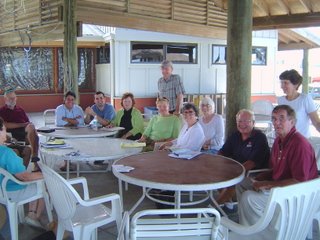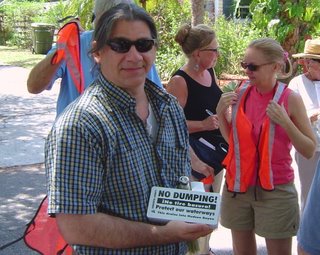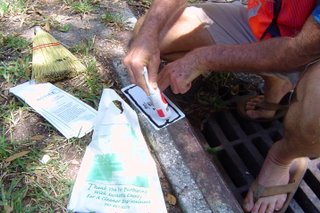Two weeks ago we published a
condensed version of the Planning Board's evaluation of the proposed density bonus plan. Here we publish the long version. It is well worth the few minutes it will take to read this as it provides great insight into this proposal.
Save Our Sarasota remains convinced that the implications of this proposal are not understood by the citizens and that unintended consequences are likely to accompany this. Issues of traffic, parking, infrastructure, etc. have not been addressed.
The following was provided by Kate Lowman as an accompanying part of the condensed version. While it may not be exactly word for word, it is very complete and has not been edited.
Shannon Snyder (Planning Board Chair)
CLOSE THE PUBLIC HEARING.
WE'LL HAVE THE CITY COME BACK DOWN.
Shawn Fulker (Planning Board Member)
(This first question refers to Doug James ‘(Planning Staff) earlier statement that overall density in the downtown area would not increase, but that instead density would be unevenly distributed across the downtown area.)
I DON'T WANT TO BE ACCUSED OF GETTING INTO THE MINUTIA, BUT WITH REGARD TO THE CONCEPT OF LIMITING A PARTICULAR AREA TO AN AVERAGE...IF HALF THE UNITS APPLY FOR A BONUS AND GET IT, ...DOES THAT MEAN THE OTHER HALF IS JUST EMPTY LAND? ...
Doug James (Planning Staff)
THE DENSITY AND THE MIX OF USES IN THE COMPREHENSIVE PLAN IS SPECIFICALLY NOTED AS NOT BEING SITE SPECIFIC. SO WHAT WE'RE SAYING IS THAT ... THE 9,003 UNITS WOULD BE CALCULATED OVER THE ENTIRE ACREAGE AND NOT ON A SPECIFIC SITE. SO IF YOU AS A DEVELOPER WANTED TO DEVELOP ALL NONRESIDENTIAL ON A 10-ACRE SITE OR ALL RESIDENTIAL, YOU COULD DO THAT AS LONG AS THE OVERALL MIX THROUGHOUT THE ENTIRE CLASS WAS NOT VIOLATED.
Shawn Fulker
WHAT THAT MEANS THEN, IS AT A CERTAIN POINT IN TIME, IF ENOUGH PEOPLE APPLY FOR BONUSES, A PERSON HAS A EMPTY LOT, (HE) WILL NOT BE ABLE TO BUILD ON THAT. ...
Doug James
THE MONITORING PROGRAM ... IS NOT ONLY TO ASSURE US THAT WE DON'T GO OVER THE MAXIMUM BUT IT'S ALSO TO ALERT US WHEN WE'RE REACHING A PERCENTAGE OF THAT MAXIMUM AND WE MIGHT WANT TO REVISIT THE COMPREHENSIVE PLAN AND PERHAPS LOWER IT ,OR INCREASE IT ,OR DO AWAY WITH IT IN TOTALITY. ... IT'S NOT THE INTENT OF THE COMPREHENSIVE PLAN TO BE WRITTEN IN GRANITE AND NEVER BE CHANGED. ...
Michael Shelton (Planning Board Member)
... THE DETAILS THAT WE WERE TOLD NOT TO WORRY ABOUT, AM I CORRECT IN ASSUMING THAT WE'RE NOT PASSING JUDGMENT, SO TO SPEAK, ON THESE DETAILS? WE'RE TALKING ABOUT A PLAN AMENDMENT AND THAT'S IT?
Michael Connolly (Planning Board Lawyer)
WE'RE TALKING ABOUT A PLAN AMENDMENT THAT DOES A NUMBER OF THINGS. ... DO YOU NEED TO WORRY ABOUT THE DETAILS OF IT TODAY? NO. ... HOWEVER, YOU DO NEED TO BE COMFORTABLE WITH THE OVERALL SCOPE OF THE PROGRAM, AND IF YOU THINK THAT THE RUDDER IS GOING IN THE WRONG DIRECTION, NOW IS THE TIME TO MAKE THAT DECISION BECAUSE YOU ARE IN THAT LEGISLATIVE FUNCTION.
Michael Shelton
BASICALLY WHAT WE'RE BEING TOLD IS “TRUST US. AND WE'LL FIGURE OUT THE DETAILS LATER.” AM I KIND OF CORRECT IN THAT?
Michael Connolly
YES. BUT THERE ARE SOME OF THE DETAILS THAT ARE SPECIFIC. FOR EXAMPLE, I THINK ONE OF THE ACTION STRATEGIES WOULD BE A NEW DEFINITION FOR WHAT IS ATTAINABLE HOUSING. THAT'S A SPECIFIC THAT YOU DO NEED TO FOCUS ON TODAY. ANOTHER ... IS THE PARTICULAR AREAS THAT THERE WOULD BE A CHANGE IN THE LAND USE CLASSIFICATION.
Michael Shelton (to ERA consultant)(This question refers to the initial ERA report last August which recommended that the City of Sarasota develop a comprehensive affordable housing plan, of which this density program might, or might not ,be one element.)
... SEEMS LIKE I READ IN AUGUST THAT YOU RECOMMENDED AGAINST DOING THIS. AND NOW WHEN ASKED ... WHAT YOUR RECOMMENDATION IS NOW, IT IS, “YES, WE RECOMMEND YOU DO DO THIS.” WHEN I ASK WHY, “WELL, I WAS TOLD TO SAY THAT.” NOW, AM I INCORRECT SOMEWHERE IN THIS?ERA
Consultant (hired by the City of Sarasota)
THANKS FOR PUTTING ME ON THE SPOT THERE. BELIEVE ME, WE HAVE TALKED ABOUT THIS AT THE FIRM. WE ALSO TALKED ABOUT THIS WITH CITY STAFF. ... THE INSTRUCTION CAME BACK FROM THE COMMISSION AND FROM THE CITY MANAGER, THE DESIRE IS TO CREATE AFFORDABLE HOUSING IN THIS AREA . ... TO START THAT PROCESS, ...THIS IS A FINE WAY TO BEGIN DOING IT. ... THERE WAS OBVIOUSLY A DESIRE ON THE PART OF THE COMMISSION AND CITY STAFF TO START IN THIS LOCATION. SO I'M NOT TRYING TO DODGE THE QUESTION. OUR ASSESSMENT ORIGINALLY WAS THIS IS PERHAPS NOT THE PLACE TO DO IT; HOWEVER, WE HAVE WORKED THROUGH THE, I THINK, SUFFICIENT DETAILS TO PUT YOU IN A POSITION TO ALLOW THIS PROCESS TO START.
Michael Shelton
...YOU ARE MAKING SPECIFIC RECOMMENDATIONS HERE. TELL ME WHERE ELSE THESE SPECIFIC RECOMMENDATIONS ARE BEING APPLIED.
ERA Consultant
I THINK THAT IS A FUNCTION OF THE SPECIFICS OF THE LOCALE.
...Michael Shelton
THERE ISN'T ANOTHER PLACE THAT DOES IT JUST LIKE THIS?
ERA Consultant
NO.
...Michael Shelton
WHAT TYPE OF INTERACTION DID YOU HAVE WITH THE ... COUNTY'S HOUSING TRUST AND WHAT TYPE OF INPUT DO THEY HAVE? AND HOW DO YOU SEE ALL THIS WORKING AS A REGIONAL SOLUTION TO THE PROBLEMS?
ERA Consultant
WE ACTUALLY MET WITH THE COUNTY REPRESENTATIVE ... ALONG WITH CITY STAFF ... AND ALSO CONVERSED WITH THEM SEVERAL TIMES DURING THE PROCESS. THERE IS A DESIRE, I THINK RIGHTLY SO, TO HAVE PARITY BETWEEN THE PROGRAMS. THE DIFFICULTY IS THE DENSITIES ARE COMPLETELY DIFFERENT. ... THEY ARE PRIMARILY TARGETED AT SINGLE-FAMILY AND ... LOWER DENSITY MULTIFAMILY UNITS, WHEREAS WE'RE TALKING ABOUT HIGH DENSITY MULTIFAMILY UNITS, PARTICULARLY CONDOMINIUMS, GIVEN THE CURRENT MARKET CONDITIONS.
Michael Shelton
...DID I HEAR YOU CORRECTLY WHEN YOU SAID ... THAT BASICALLY IT'S NOT ECONOMICALLY FEASIBLE TO DEVELOP CONDOS NOW?
ERA Consultant
IF YOU WERE A DEVELOPER ENTERING THE MARKET COLD, TODAY, ... YOU WOULD NOT RATIONALLY CHOOSE TO ENTER THIS MARKET UNDER CURRENT CONDITIONS. NOW, IF YOU HAD A DEVELOPMENT PARTNER WHO IN SOME WAY WAS ALREADY VESTED, IT'S DIFFERENT.
Michael Shelton
...IT SEEMS TO ME LIKE A MAJOR COMPONENT OF THIS IS TO ENCOURAGE THE BUILDING OF NEW UNITS, ... AND I'M NOT SURE THAT THAT'S SOMETHING THAT WE OUGHT TO BE DOING. ONLY 10% OF THE UNITS WILL MEET A SPECIFIC NEED. 90% OF THE UNITS ARE GOING TO MAKE A PROFIT FOR THE DEVELOPER. IF IT'S NOT ECONOMICALLY FEASIBLE TO DO IT TO BEGIN WITH, WHY DO WE WANT TO CREATE A SYSTEM SO THAT THE DEVELOPERS CAN MAKE MONEY AND WE END UP WITH A VERY SMALL NUMBER OF UNITS THAT SATISFY NEEDS?
ERA Consultant
...WHILE AT THE END OF THE DAY THE DEVELOPERS ARE BUILDING MORE UNITS AND THEY ARE CERTAINLY MAKING HIGHER PROFIT MARGIN ON THOSE UNITS, AND THEIR TOTAL PROFIT WILL BE HIGHER, THAT IS BEING USED TO PAY FOR THE AFFORDABLE UNITS. SO YOU'RE, IN ESSENCE, RECAPTURING THAT MONEY. ...YOU'RE GETTING AFFORDABLE UNITS THAT YOU WOULDN'T HAVE GOTTEN OTHERWISE.
Michael Shelton
WELL, OKAY. HOW DID YOU COME UP WITH THE 10% NUMBER?
ERA Consultant
WE RAN THE NUMBERS TO SEE WHERE APPROXIMATELY PERHAPS THE POTENTIAL EXISTED FOR THE DEVELOPMENT OF THOSE ATTAINABLE UNITS AND THE BALANCING ENTICEMENT OF ADDITIONAL DENSITY.
Michael Shelton
SO IT TAKES 130 UNITS AT MARKET PRICE TO OFFSET THE REDUCTION IN PRICE FOR THE 20 UNITS THAT WE'LL GET? AND WHAT WAS THE AVERAGE SALES PRICE THAT YOU HAD FOR 130 UNITS?
ERA Consultant
IT DEPENDED UPON THE LOCATION WE WERE IN. I THINK IN THE DOWNTOWN EDGE AND I THINK IN THE CORE WE WERE AT 600,000 A UNIT. AND WE USED AN AVERAGE UNIT SIZE. ...1250 SQUARE FEET. ...
Michael Shelton
SO IF, FOR EXAMPLE, IN ITS INFINITE WISDOM, THE COMMISSION ULTIMATELY DECIDES IT WANTS 20% INSTEAD OF 10%, THEN IT WOULD BE YOUR CONCLUSION THAT (THIS) WOULD UNDERMINE THE ENTIRE PROGRAM...?
ERA Consultant
WELL, AGAIN, IT'S A VOLUNTARY PROGRAM.
Michael Shelton ...
WAS THERE ANY ANALYSIS OF THE HOUSING STOCK WITHIN THE CITY?
ERA Consultant
OTHER THAN THE EXISTENCE OF THE UNITS, NO, OF WHAT'S THERE AT THE MOMENT AS TOTAL COUNT.
Michael Shelton
AND NOBODY HAS DONE AN OVERALL, THOROUGH AND COMPREHENSIVE ANALYSIS AS TO WHAT OTHER OPTIONS WE MIGHT HAVE TO DO THIS, WHAT OTHER ASSETS WE MIGHT HAVE WITHIN THE CITY?
...ERA Consultant
(AS) PART OF THE STUDY BACK IN AUGUST, WE RECOMMENDED A COMPREHENSIVE HOUSING STRATEGY ... BE DEVELOPED FOR THE CITY.
...Michael Shelton ...
WAS THAT DONE?
ERA Consultant
WE DIDN'T DO IT. WE WEREN'T TASKED WITH THAT.
Michael Shelton
BUT DO YOU HAVE ANY KNOWLEDGE ABOUT THAT RECOMMENDATION?
ERA Consultant
I DON'T.
Michael Shelton
WAS ONE EVER DONE?
ERA Consultant
NOT TO MY KNOWLEDGE.
Michael Shelton
WAS IT EVER DISCUSSED?
ERA Consultant
I DON'T KNOW THAT EITHER.
Michael Shelton
WHAT ABOUT RENTAL UNITS? ... WAS THERE ANY ANALYSIS OF OUR RENTAL SUPPLY OR RENTAL NEEDS? I'M HAVING A REAL TOUGH TIME ENVISIONING A FIVE-YEAR POLICEMAN WITH WIFE AND TWO KIDS MOVING INTO A BAYFRONT CONDO AND THINKING THAT WOULD BE ADEQUATE HOUSING FOR THEM. IT'S JUST NOT WORKING FOR ME. ... GRANTED, NOTHING WILL BE A SINGLE SOLUTION. BUT I JUST DON'T KNOW THAT WE ARE FULLY EXAMINING ALL THE OPTIONS AND LOOKING AT THE FULL GLOBAL PICTURE. ... I CAME FROM MARYLAND AND I KNOW YOU KNOW THAT VERY WELL. WOULD YOU AGREE THAT THEY HAVE PROBABLY A FIRST-CLASS HOUSING OPPORTUNITIES COMMISSION? THEY KNOW WHAT THEY ARE DOING?
ERA Consultant
THEY HAVE A LARGE STAFF. WE CONSULTED WITH THEM IN THE COURSE OF THIS PROJECT.
Michael Shelton
I CAN'T BELIEVE THAT THEY AGREED WITH MUCH OF ANYTHING IN HERE. I WOULD BE ABSOLUTELY SHOCKED AND APPALLED IF THEY AGREED WITH MUCH OF ANYTHING IN THIS REPORT. THAT'S NOT BEING CRITICAL OF YOUR REPORT, THIS ISN'T THE WAY THEY DO IT THERE, IS IT?
ERA Consultant
WELL, THEY ARE ONE OF THE EARLIEST PROGRAMS IN THE UNITED STATES.
...Michael Shelton
WOULD YOU SAY IT'S BEEN A RATHER -- VERY, VERY SUCCESSFUL?
ERA Consultant
THE POSTER CHILD, IF I MAY SAY, OF THE AFFORDABLE HOUSING WORLD.
Michael Shelton
AND I WOULD BE HARD PRESSED TO FIND MUCH OF ANYTHING IN THIS THAT CORRESPONDS TO THE WAY THEY DO IT THERE. I'M A FIRM BELIEVER IN NOT REINVENTING THE WHEEL. ... TRYING TO FORCE FAMILIES INTO HIGH-RISE CONDOS THAT HAVE DOORMEN AND ... EXPENSIVE AMENITIES AND NOT HAVE A REAL SOLUTION AS TO HOW TO PAY FOR THE CONDO FEES, I JUST DON'T SEE IT WORKING. ... I'M A BIG, BIG PROPONENT OF INCLUSIONARY ZONING. ... I DON'T THINK THIS IS WELL THOUGHT OUT.
...Jennifer Wilson (Planning Board Member)
WHEN MR. VENGROFF WAS DOWN HERE, (HE SAID) HE WANTS TO DO 1600 UNITS.
...ERA Consultant
WELL, WE MET WITH HIM AS A PART OF THE PROCESS.
...Jennifer Wilson
I LIVE IN PARK EAST. ... WHY WOULDN'T YOU GIVE HIM THE DENSITY HE NEEDS?
ERA Consultant
I CAN'T ANSWER THAT QUESTION. I DON'T KNOW.
Jennifer Wilson
HERE IS A GUY THAT WANTS TO DO A PROJECT THAT IS SOMETHING THAT'S WORTHWHILE. DOESN'T WANT ANY CITY MONEY. AND THEN WE PUT ANOTHER HAND BEHIND HIS BACK.
...Doug James
WHETHER WE LIKE IT OR NOT, WE DO HAVE A PROCESS. PART OF IT IS MANDATED BY THE STATE. ... THE FIRST STEP IN THE PROCESS IS ... ALLOWING WHATEVER PARCEL HE OWNS TO BE RECLASSIFIED TO THE DOWNTOWN URBAN MIXED-USE CLASS. THE BEST YOU CAN GET OUT OF THAT AS WE SIT HERE IS 50 DWELLING UNITS AN ACRE.
...Jennifer Wilson
LET'S GO OVER TO AREA FIVE. THANK GOD THE PLANNING GOD HAS PULLED OUT MY STREET, BECAUSE IT'S THE ONLY PART OF PARK EAST THAT'S SINGLE-FAMILY WHERE YOU HAVE 12 HOMES, YOU HAVE 11 THAT ARE OWNER OCCUPIED. WHEN YOU GO OVER TO THE OTHER SIDE OF LIME ... AND WE REZONE THAT, WHAT HAVE WE NOW DONE TO THE ONLY DECENT PART OF PARK EAST IF WE PUT HIGH-RISES ALONG LIME AVENUE? DO YOU SEE WHAT WE'RE THINKING HERE?
Doug James
ALL WE HAVE BROUGHT BEFORE YOU THIS EVENING IS A LAND USE CLASS IN TERM OF A MAP CHANGE.
...Jennifer Wilson
BUT WE, THE PEOPLE, HAVE COLD FEET. ... THAT'S WHY WE HAD THIS CROWD OUT HERE TONIGHT. THEY ARE AFRAID OF WHAT MIGHT HAPPEN IF THEY LOOK AWAY. THEY ARE AFRAID OF WHAT MIGHT HAPPEN IF THEY QUIT BEING FOREVER VIGILANT. AS THE NEIGHBORHOOD DEPARTMENT TELLS PEOPLE, IT'S OUR RESPONSIBILITY TO PROTECT OUR NEIGHBORHOODS. ... I JUST DON'T KNOW WHY WE GO ALL THE WAY AROUND IT. WE ASK FOR INPUT--WE DON'T TAKE THE SUGGESTIONS THAT ARE GIVEN, AND THEN WE HAVE A SPACESHIP LAND IN THE MIDDLE OF PARK EAST WITHOUT ANY NEIGHBORS KNOWING WHAT WAS HAPPENING TO THEM. IT'S JUST NOT FAIR. THAT'S ALL I GOT.
Shannon Snyder:
CLOSE THE PUBLIC HEARING. IS THERE A MOTION? RECOMMEND --
[INAUDIBLE].(Motion by Robert Lindsay, seconded by Jennifer Wilson, to reject the comp plan amendments.)
Shannon Snyder:
MOTION HAS BEEN MOVED AND SECONDED.
Robert Lindsay (Planning Board Member)
...WE ... GET ONE ATTAINABLE UNIT FOR EVERY 10 EXPENSIVE ONES WE BUILD. THE PEOPLE THAT COME TO TOWN AND (CAN) AFFORD A 2 MILLION-DOLLAR CONDO ARE TYPICALLY GOING TO NEED PROBABLY A REVERSE RATIO, MORE LIKE TEN SUPPORT PEOPLE FOR EVERY ONE OF THEM. SO WE'RE NOT MAKING A SIGNIFICANT DENT IN THE PROBLEM IF WE BUILD A HUNDRED OF THESE -- A HUNDRED EXPENSIVE UNITS THAT ARE GOING TO REQUIRE A THOUSAND PEOPLE IN THE GENERAL POPULATION TO SUPPORT THEM. PLUMBERS, ELECTRICIANS, LAWYERS, LAW CLERKS, ALL THESE OTHER PEOPLE. SO IT'S NOT REALLY DOING A WHOLE LOT. THE OTHER THING IS THAT ... WE'RE GOING TO HAVE A PROFESSIONAL DIRECTOR OF THIS PROGRAM. THAT PERSON IS GOING TO HAVE A SECRETARY, FLOOR SPACE, PROBABLY A CITY CAR. ... MORE COSTS LATER FOR ARCHIVING ALL THIS STUFF, ON AND ON. ... SO I THINK YOU CAN EASILY SEE ...THE COST OF THE PROGRAM WINDING UP ...IN THE CITY'S BUDGET, IF YOU TAKE IN ALL THE FACTORS OF FLOOR SPACE AND EVERYTHING ELSE, SOMETHING OVER A MILLION BUCKS A YEAR. WELL, AT A MILLION BUCKS A YEAR, THE LOW END OF OUR PROJECTED GAIN HERE IS 230 AFFORDABLE UNITS. WE CAN JUST ABOUT MEET THAT BY HAVING THE CITY WRITE A CHECK TO SARASOTA MEMORIAL HOSPITAL FOR $50,000 GRANTS TO DESERVING NURSES FOR THEIR HOUSING. SO, IT MAKES NO SENSE TO GO THROUGH THIS HUGE EFFORT HERE. WE CAN JUST SOLVE IT WITH SOME CASH AND NOT HAVE TO SIT HERE THROUGH ALL OF THIS. ...THE SOLUTION HERE IS VERY SIMPLE, REALLY. ... THE WHOLE CITY WAS BASED ON A DENSITY AND LOT SIZE BASE FORM OF REGULATION A WHILE AGO. WE CHANGED TO A FORM-BASED REGULATION WHEN WE WENT WITH DUANY'S PLAN WHERE WE REGULATE THE PHYSICAL CONFIGURATION OF THE OUTSIDE OF THE BUILDING. I DON'T THINK WE SHOULD REALLY CARE WHETHER THE DEVELOPER BUILDS 800-SQUARE-FOOT UNITS OR 8,000-SQUARE-FOOT UNITS. RIGHT NOW, THEY HAVE NO INCENTIVE TO BUILD SMALLER. ... IF YOU ELIMINATE THE REFERENCES TO DENSITY, THEN A DEVELOPER, ... HAS THE OPTION TO BUILD THE SIZE OR MIX OF SIZES THAT HE THINKS WILL SELL AND BE THE MOST PROFITABLE. AND MAYBE WE'LL GET SOME 800-FOOT STUDIO APARTMENTS FOR THE SINGLE ...YOUNG PROFESSIONAL. AND SOME 1200-FOOT APARTMENTS FOR A RETIRED COUPLE.... ... THE SIMPLE THING (IS) WE GO IN THERE AND ELIMINATE REFERENCES TO DENSITY IN THE DOWNTOWN CORE AND DOWNTOWN BAYFRONT. AND THAT PRETTY WELL WILL PROBABLY CURE THE PROBLEM AT LEAST IN THE DOWNTOWN AREA WITHIN THE NEXT FEW YEARS WITHOUT THE CITY SPENDING A LOT OF MONEY AND PUTTING ALL THE NEIGHBORHOODS AND EVERYBODY ELSE THROUGH ALL THIS PAIN.
... Jennifer Wilson
I THINK MR. LINDSAY SAYS IT, WE'RE JUST NOT GETTING ENOUGH BANG FOR THE BUCK HERE.
... Shawn Fulker
...THE THING IS, THEY ARE TRYING TO PUT THE AFFORDABLE STUFF IN THE MIDDLE OF THE MOST EXPENSIVE LAND. ... THAT'S WHY THE NUMBERS AREN'T WORKING OUT, BECAUSE THE DIRT IS SO EXPENSIVE, DOESN'T MATTER HOW MANY UNITS YOU GIVE THEM, IT'S ALMOST NOT -- IT ALMOST NEVER WOULD BE WORTH DOING. ... THE MODEL, I THINK, NEEDS TO BE REEXAMINED. I HATE SAYING THAT BECAUSE I REALLY THINK WE NEED SOME DENSITY INCREASES. ... SO WE'RE GOING TO SEE WHAT'S GOING TO HAPPEN TWO, THREE YEARS DOWN THE ROAD, IF THERE REALLY IS A SERIOUS PROBLEM. ... FOR YEARS, YOU HEAR ABOUT PEOPLE DRIVING FROM NORTH PORT AND ... ST. PETE ...TO COME HERE, AND EVEN DEPARTMENT HEADS OF THE CITY, OR AT LEAST ONE, DRIVES THAT FAR BECAUSE THEY CAN'T AFFORD TO LIVE IN THE CITY, SUPPOSEDLY. BUT YET THERE ARE ALL THESE HOUSES FOR SALE. I WISH THERE WAS AN INVENTORY DONE, FRANKLY, AND OUTSIDE OF (INCLUDING?) THE COUNTY. WE'RE BEARING THE BURDEN OF TRYING TO FIGURE OUT HOW TO FIT ALL THIS AFFORDABLE HOUSING IN A CITY THAT'S FIVE MILES BY SEVEN MILES OR SOMETHING LIKE THAT. MOST OF THAT IS BEACH FRONT OR WATERFRONT, REALLY NOT EVEN IN PLAY. I DON'T SEE HOW YOU CAN DO THIS WITHOUT LOOKING INTO THE COUNTY. ... I DON'T THINK WE'LL MIND DRIVING A FEW MILES DOWN FRUITVILLE. IT SEEMS TO ME TO BE THE PERFECT SPOT. ... AS MUCH AS I WOULD LOVE TO BE ABLE TO SAY, HEY, LET'S APPROVE THIS THING AND JUST SEE IF IT WORKS, I DON'T KNOW IF I CAN. I HAVEN'T HEARD ANYTHING THAT REALLY CONVINCED ME OF THAT.
Michael Shelton
AS MUCH AS I HATE TO SAY IT, I CAN'T SUPPORT THIS. AND I'VE TRIED AND TRIED TO THINK OF A REASON WHY I CAN DO THIS AND HOW I CAN MAKE IT WORK, BUT I CAN'T. AND TO BE HONEST..., THE TWO PEOPLE THAT I THOUGHT ... MIGHT SUPPORT THIS, THEY DON'T EVEN SUPPORT IT, WHICH MAKES ME EVEN MORE NERVOUS. ... I DON'T THINK THAT IT REALLY GOES NEARLY FAR ENOUGH TO SOLVE ...WHAT WE'RE TRYING TO ACCOMPLISH HERE. I'M REALLY, REALLY NERVOUS ABOUT KNOWING WHAT THE REAL END PRODUCT IS GOING TO LOOK LIKE. IF I WERE TO SUPPORT THIS, (I’VE) GOT A REAL FEAR THAT WHAT I'LL END UP WITH IS THIS ABILITY TO HAVE A MUCH, MUCH HIGHER LEVEL OF DENSITY WITH A PROGRAM THAT I'M COMPLETELY OPPOSED TO. ...I CAN GO DOWN THE LIST HERE AND CHECK OFF THE THINGS THAT I DON'T LIKE ABOUT THE PROPOSAL. I DON'T THINK IT GOES NEARLY FAR ENOUGH. I'M ALSO BEING TOLD THAT IT'S JUST NOT ECONOMICALLY FEASIBLE TO RAISE THE PERCENTAGE OF AFFORDABLE HOUSING UNITS THAT CAN COME OUT OF THE PROGRAM, AND 10% IS NOT ENOUGH OF A RETURN ON THE INVESTMENT THAT WE'RE BEING ASKED TO MAKE. JENNIFER SAID THERE WASN'T ENOUGH BANG FOR THE BUCK, AND (THAT) PROBABLY REDUCES IT TO THE BOTTOM LINE FOR ME. ... THIS IS A REGIONAL PROBLEM. ... IT'S NOT OUR PROBLEM ALONE, SO I DON'T KNOW WHY WE NEED TO THINK THAT WE'RE GOING TO SOLVE IT WITHIN OUR BOUNDARIES BY OURSELVES. THIS ... NEEDS TO BE TAKEN ON BY THE COUNTY, THE CITIES. ... WE ALL HAVE TO GET TOGETHER AND LOOK AT IT AS A REGIONAL ISSUE, AND I DON'T SEE ANY EVIDENCE OF THAT BEING DONE. IN FACT, THERE WAS A RECOMMENDATION THAT THAT BE DONE. AND FOR SOME REASON, IT WASN'T DONE. I REAFFIRM MY SUPPORT FOR THIS CONCEPT. I JUST DON'T SEE THIS PLAN AS BEING THE ONE THAT DOES IT, AND I CAN'T SUPPORT IT.
Shawn Fulker
MAY I ADD ONE QUICK PIECE? I WAS LOOKING DOWN AT MY NOTE, ONE DANGEROUS THING HERE, TOO, IF YOU APPROVE THIS DENSITY THING -- AND I CAN SPEAK TO THIS FIRST HAND -- THE PROPERTY VALUES ARE GOING TO GO UP BECAUSE YOU CAN BUILD MORE UNITS. THEN WHEN THE PERSON GOES IN TO DEVELOP IT, THEY SPEND MORE MONEY ON THE LAND AND THEN IT MAKES THE PROJECT NOT FEASIBLE TO BUILD THEM AT A CHEAPER PRICE. YOU HAVE TO BE REAL CAREFUL ON HOW YOU DO THIS DENSITY THING.
Shannon Snyder
I'M GOING TO SUPPORT THE MOTION FOR DENIAL. THIS IS A TROJAN HORSE. JOHN SUSCE WAS RIGHT WHEN HE CALLED IT THAT. THE ATTAINABLE HOUSING ISSUE IS SEPARATE FROM THIS PLAN RIGHT HERE. IF THIS IS APPROVED, WHAT THIS WILL DO IN FIVE YEARS IS WHAT THE LEVEES DID IN FIVE HOURS TO NEW ORLEANS. NO IFs, ANDs AND BUTS. IT WILL BASICALLY TELL ANYBODY THAT IS MAKING LESS THAN $100,000 A YEAR -- THE CLOCK IS TICKING ON YOU AND YOU BETTER GO DOWN TO U-HAUL AND GET SOME BOXES. ... TRYING TO PUT ATTAINABLE HOUSING IN DOWNTOWN IS LIKE TALKING ABOUT PUTTING ATTAINABLE HOUSING OUT ON ST. ARMANDS. IT'S JUST NOT GOING TO HAPPEN. I MEAN, ARE THERE OPPORTUNITIES ONCE IN A WHILE? SURE. I'M SURE MR. VENGROFF HAS A GOOD SHOT AT DOING SOMETHING WITH HIS PROPERTY. BUT THAT IS A DEDICATED INDIVIDUAL DEDICATED TO A PROJECT. HE'S A SPECIAL INDIVIDUAL. THIS WHOLE PROCESS -- AND -- I MEAN, COULD I RIP THE REPORT APART, BUT I REALLY CAN'T FAULT THE CONSULTANT. (HE) TOLD (THEM) BACK IN OCTOBER IT'S NOT GOING TO WORK. ... AS FAR AS FAST TRACKING, I'M CHAIRMAN OF THE BOARD, I HEARD ABOUT IT AFTER OUR EAR PROCESS. THIS IS THE FIRST TIME I HEARD ABOUT IT. YEAH, IT'S BEING FAST TRACKED. I DON'T CARE WHAT SPIN ANYBODY IS TRYING TO PUT ON, IT'S BEING FAST TRACKED. IT'S NOT RIGHT TO DO TO THESE NEIGHBORHOODS. BASICALLY, ...ANYTHING WITHIN A TWO-MILE RADIUS OF DOWNTOWN WOULD BE OVERRUN WITH SPECULATORS OVERNIGHT IF THIS IS APPROVED AND BASICALLY -- I MEAN, WE ALREADY HAVE AN ECONOMIC REALITY IN THIS COMMUNITY THAT ALL OF US AGREE ON, THAT IT IS BECOMING MORE EXPENSIVE. I CAN'T BE A PARTY TO SHOVING MY NEIGHBORS OUT OF TOWN. YOU KNOW, THERE ARE PEOPLE I GREW UP WITH. I LIVE IN THE NEIGHBORHOOD I GREW UP IN. I ACTUALLY LIVE ON THE STREET I GREW UP ON. I PHYSICALLY AND EMOTIONALLY CANNOT SHOVE MY NEIGHBORS AND MY FRIENDS OUT OF HERE JUST BECAUSE WE'RE GOING TO MAKE A COUPLE OF DOLLARS. ... THEN I'LL TALK ABOUT THE ATTAINABLE HOUSING. TWO PIECES OF PROPERTY IF ANYBODY WANTS TO LOOK AT THEM, TUTTLE AVENUE AND MYRTLE, NORTH SIDE AND SOUTH SIDE, THERE'S PLENTY OF PROPERTY. LITTLE EXTRA DENSITY, YOU'RE TALKING OVER A THOUSAND UNITS. GO TO THE END OF 17th STREET, HANG A LEFT, NORTH ON HONORE AVENUE, NORTH ON METRO PARK, COUNTY OWNS MORE THAN A MILE OF LAKEFRONT PROPERTY YOU COULD PUT 2,000 UNITS OF ATTAINABLE HOUSING RIGHT THERE. THIS COULD BE OCCUPIED IN TWO YEARS IF THERE WAS A POLITICAL WILL TO DO IT. THERE'S SEWER, WATER, ELECTRIC TO ALL THE PROPERTY, LARGE ENOUGH TO SUPPORT ALL OF IT. THIS IS A REGIONAL PROBLEM. THIS IS NOT GOING TO BE SOLVED INSIDE THE CITY, AND WE NEED TO STEP BACK AND SAY, LISTEN, ANYTHING WITHIN A NINE MILE RADIUS OF FIVE POINTS WE NEED TO BE LOOKING AT FOR ATTAINABLE AND AFFORDABLE HOUSING FOR OUR EMPLOYEES AND THE REST OF THE COMMUNITY. AND I JUST -- I THINK -- ILL-PLACED AND A COLOSSAL WASTE OF MONEY THIS WHOLE THING.
CALL THE VOTE. (a yes vote is to support the motion for denial, rejecting the density bonus program.)
Shawn Fulker: YES.
Michael Shelton: YES.
Robert Lindsay: YES.
Jennifer Wilson: YES.
Shannon Snyder: YES.
 A small group of people is actively working to find a way that Paul Rudolph’s Riverview High School main building can be saved - probably by using it as an integral part of a design for the new proposed campus.
A small group of people is actively working to find a way that Paul Rudolph’s Riverview High School main building can be saved - probably by using it as an integral part of a design for the new proposed campus.











